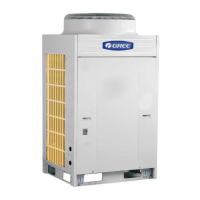Instruction of the GMV D.C. inverter
19
manifold and then passes the throttling component for decrease of pressure and temperature. The
liquid then enters the heat exchanger of the indoor unit and carries out heat exchange with the
room air to be regulated. The liquid then changes into low-temperature and low-pressure gas. Such
cycle repeats again and again to achieve the purpose of cooling. When the system turns to heating
operation, the 4-way reversing valve with solenoid coil shall be started to cause the heating cycle
follows an adverse course compared with the course of the cooling cycle. The refrigerant radiates
heat in the heat exchanger of the indoor unit (the electric heating component also starts operation
and radiates heat) and absorbs heat from the heat exchanger of the outdoor unit to carry out heat
pump heating cycle for the purpose of heating.
8 Types of Indoor Units to Be Integrated
Diagram of System Integration
Ducted Indoor Unit
(Rectangular Air Outlet)
Single Side Air
Supply Indoor Unit
Cassette Indoor Unit
Wall-Mounted
Indoor Unit
Floor Standing
Indoor Unit
Mini D.C.Inverter multi-connected air-conditioning unit consists of one outdoor unit and up to
16 indoor units. The indoor unit can be of cassette type,single side air supply type,wall-mounted
type, ducted type, and oor standing type, etc. The wall-mounted type and the oor standing type
indoor units are controlled by remote controller; the ducted indoor unit is controlled by remote
controller and wire controller. For the cassette indoor unit and single side air supply cassette indoor
unit, remote controller or wire controller can be freely chosen. When any indoor unit receives an
operation order, the outdoor unit shall start operation; when all indoor units stop operation, the
outdoor unit shall stop.

